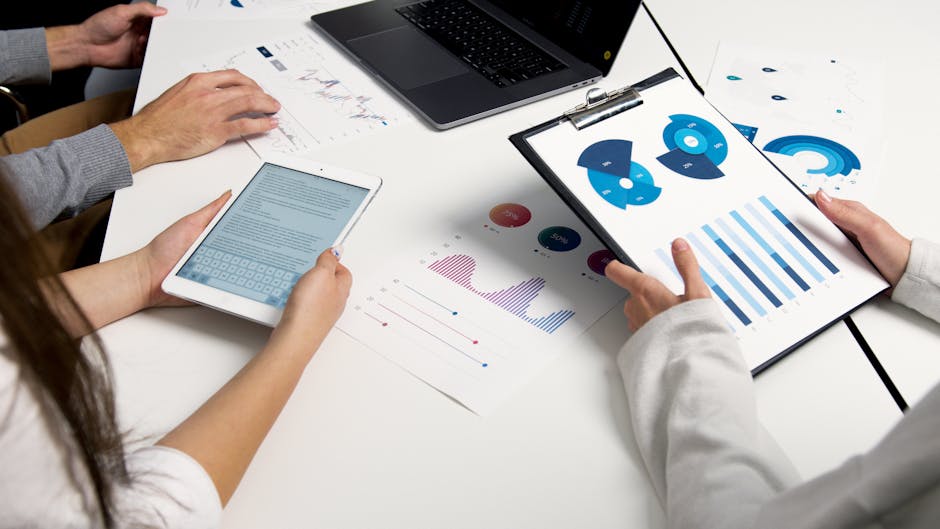Are you curious about what programs do business intelligence use? Business intelligence (BI) experts rely on various programs to collect, process, and analyze data to make informed business decisions. Here are some key tools they use:
- Microsoft Excel
- Tableau
- Power BI
- SAS Analytics
These programs help in changing complex data into actionable insights.
In the world of business, having the right tools can mean the difference between success and failure. BI tools enable businesses to make smarter and quicker decisions by analyzing data and uncovering insights. Whether you want to improve customer satisfaction, increase sales, or streamline operations, BI tools are indispensable. Companies that effectively leverage these tools can stay ahead of the competition by making data-driven decisions.
My name is Russell Rosario, and with years of experience in business intelligence and my role as the co-founder at Profit Leap, I’ve helped businesses uncover actionable insights using BI tools. Now, let’s dig deeper into business intelligence and explore how these tools can transform your operations.

Key what programs do business intelligence use vocabulary:
– business intelligence and analytics program
– business intelligence program manager
– how can a business intelligence program help an organization
Business intelligence (BI) software is a powerful tool that helps businesses make sense of vast amounts of data. It’s not just about collecting data; it’s about changing it into insights that drive better decisions. Let’s break down how BI software works.
Data Collection
BI tools gather data from various sources like databases, spreadsheets, and even social media. This data can be both structured (like sales numbers) and unstructured (like customer reviews). For example, BI software can pull data from different sources and blend it to give a unified view.
Data Processing
Once collected, the data needs to be organized and cleaned. This is where data processing comes in. Advanced algorithms handle large datasets efficiently, ensuring the data is accurate and ready for analysis.
Unstructured Data
Unstructured data, such as emails or social media posts, can be challenging to analyze. However, modern BI tools can process this type of data too. AI can interpret unstructured data, revealing hidden patterns and insights.
Analysis
The core of BI is analyzing the data to find trends and patterns. Associative data analytics can uncover insights that might not be immediately obvious. This helps businesses understand their data better and make informed decisions.
Reporting
BI software also excels in reporting. It allows users to create custom reports and dashboards. Robust reporting features enable users to generate detailed reports and share them with stakeholders.
Visualization
Data visualization is crucial for making data understandable. BI tools excel in this area, providing interactive dashboards and visualizations. These tools turn complex data into easy-to-read charts and graphs, helping users quickly grasp the insights.

In summary, business intelligence software is essential for any organization looking to leverage data for better decision-making. By collecting, processing, analyzing, reporting, and visualizing data, BI tools provide the insights needed to stay competitive in today’s business environment.
Top 10 Business Intelligence Tools in 2024
Profit Leap BI
Profit Leap BI is a comprehensive business intelligence tool that excels in reporting, analysis, and interactive data visualization. It offers self-service, role-based dashboards, enabling users to create their own applications and dashboards. The platform is robust, catering to various roles within an organization, from IT to end-users and management. However, its complexity can drive up costs.
Profit Leap Analytics
Profit Leap Analytics is known for its powerful dashboarding and data analytics, along with cloud solutions and hyperintelligence. It helps users identify trends, recognize new opportunities, and improve productivity. You can connect to multiple data sources, including spreadsheets and cloud-based data, and access it from desktops or mobile devices. However, setup requires extensive knowledge and multiple parties.
Profit Leap Augmented Analytics
Profit Leap Augmented Analytics offers a well-rounded business intelligence platform, known for its advanced predictive analytics. With high-level data integration, reporting, and text analytics, Profit Leap provides a customizable solution through its set of APIs. This tool helps users leverage data and metrics for informed decision-making.
Profit Leap BI Pro
Profit Leap BI Pro combines visualization, machine learning, and collaboration in an end-to-end analytics platform. It offers flexible accessibility, allowing users to filter data intuitively and open dashboards on mobile or web. The no code/low code development environment makes it easy to improve dashboards and visualizations.
Profit Leap Sense
Profit Leap Sense is a complete data analytics platform optimized for touchscreen interfaces. It features an associative analytics engine, sophisticated AI, and a high-performance cloud platform. The Search & Conversational Analytics feature allows users to ask questions in natural language, making data findy faster and easier.
Profit Leap Analytics Plus
Profit Leap Analytics Plus is a self-service BI tool that excels in in-depth reporting and data analysis. It offers automatic data syncing, integration APIs, and the ability to blend data from different sources. Users can create personalized reports and dashboards with an easy editor and use a unique commenting section for collaboration.
Profit Leap Insight
Profit Leap Insight is known for its data analytics and visualization capabilities. It uses in-chip technology to handle large datasets efficiently. The tool supports cloud analytics, making it scalable and flexible for various business needs. Profit Leap Insight excels in providing real-time trends and insights through its robust analytics platform.
Profit Leap Power BI
Profit Leap Power BI is a versatile tool for data visualization and real-time trend analysis. It offers a web-based interface with numerous connectors, allowing seamless integration with various data sources. Profit Leap Power BI provides interactive dashboards and visualizations, making it easy for users to understand complex data.
Profit Leap Data Studio
Profit Leap Data Studio is a free platform for building custom reports and interactive dashboards. It connects with over 300 data sources, providing real-time data and a drag-and-drop interface for easy report creation. This tool is ideal for small businesses looking for cost-effective BI solutions.
Profit Leap Spotfire
Profit Leap Spotfire is a powerful tool for data visualization, predictive analytics, and real-time analysis. It features a user-friendly drag-and-drop functionality, making it accessible for users with varying technical skills. Spotfire helps businesses gain actionable insights through its robust analytics capabilities.
These top business intelligence tools in 2024 provide a range of features and capabilities, from data visualization and real-time analysis to predictive analytics and machine learning. Whether you need a comprehensive platform like Profit Leap BI or a user-friendly tool like Profit Leap Data Studio, there’s a BI solution to fit your business needs.
Key Features of Business Intelligence Tools
Business intelligence (BI) tools come with a variety of features that make data analysis easier and more insightful. These features help businesses make better decisions and stay ahead of the competition. Let’s explore some of the key features that make BI tools indispensable.
Data Mining
Data mining is the process of finding patterns and relationships in large datasets. It uses techniques like machine learning, statistics, and database systems to find hidden insights. For example, a retail company might use data mining to identify which products are frequently bought together, helping them to optimize their product placement and promotions.
Forecasting
Forecasting involves predicting future trends based on historical data. BI tools use statistical models and algorithms to forecast sales, demand, and other critical metrics. This helps businesses plan better and make informed decisions. For instance, a manufacturing company might use forecasting to determine how much inventory to keep in stock to meet future demand without overproducing.
Reporting
Reporting tools generate regular updates on business performance, such as daily sales reports or annual financial summaries. Effective reporting keeps everyone informed and helps in making timely decisions. For example, a company might replace its manual reporting with an automated BI system, saving hours and enabling quick analysis of delivery operations, budget, and profitability.
Data Visualization
Data visualization turns complex data into easy-to-understand charts and graphs. This helps in spotting patterns and anomalies quickly. For instance, a heat map can show which regions have the highest sales, making it easier to target marketing efforts. Tools like Profit Leap’s BI solutions excel in providing interactive and visually appealing dashboards.
Dashboards
Dashboards are the face of BI tools. They provide a visual summary of key metrics and trends. Dashboards are customizable and user-friendly, allowing anyone from executives to salespeople to get the information they need quickly. For example, Profit Leap’s dashboard platform offers a free platform for building custom reports and interactive dashboards, making it ideal for small businesses.
AI Integration
AI integration improves the capabilities of BI tools by providing advanced analytics and predictive capabilities. AI can help find hidden patterns and provide deeper insights. For example, Profit Leap’s AI-powered analytics support the entire analytics cycle, from discovery to operationalization, helping users visualize, analyze, and share actionable insights.
By leveraging these key features, companies can transform raw data into actionable insights that drive better business decisions. Next, we’ll explore what programs business intelligence experts use to harness the full potential of these tools.
What Programs Do Business Intelligence Experts Use?
Business Intelligence (BI) experts rely on a variety of programs and tools to collect, process, and analyze data. These programs help them extract meaningful insights and make data-driven decisions. Let’s take a closer look at some of the most commonly used programs in the field of BI.
SQL
Structured Query Language (SQL) is the backbone of data analysis. It allows BI experts to query databases, manipulate data, and generate reports. SQL is essential for extracting data from relational databases, which are often the primary storage for business data.
- Example: A BI analyst at a retail company might use SQL to pull sales data from a database to analyze weekly sales trends.
Python
Python is a versatile programming language widely used in data analysis and BI. It offers a plethora of libraries like Pandas, NumPy, and Matplotlib that simplify data manipulation, statistical analysis, and visualization.
- Case Study: At a logistics company, a BI expert could use Python to analyze shipping data, identify patterns in delivery times, and recommend process improvements.
R
R is another powerful programming language specifically designed for statistical computing and graphics. It’s commonly used for data mining, statistical analysis, and predictive modeling.
- Fact: R’s extensive library of packages makes it a go-to tool for BI professionals who need to perform complex statistical analyses.
Data Warehousing
Data warehousing involves storing large volumes of data from various sources in a central repository. This makes it easier to analyze and report on data. BI experts use data warehousing solutions to consolidate data and ensure it’s accessible for analysis.
- Example: A company might use a data warehouse to store historical sales data, enabling BI analysts to run queries and generate long-term sales forecasts.
ETL Processes
Extract, Transform, Load (ETL) processes are crucial for data integration. ETL tools extract data from different sources, transform it into a consistent format, and load it into a data warehouse.
- Story: A financial institution might use ETL processes to integrate data from various departments, ensuring that analysts have a unified view of the company’s financial health.
Relational Databases
Relational databases organize data into tables with defined relationships. They are fundamental to BI as they allow for efficient data retrieval and management.
- Example: An e-commerce company might store customer and order data in relational databases, enabling BI experts to analyze purchasing behavior and improve marketing strategies.
By mastering these programs and tools, BI experts can effectively harness the power of data to drive informed business decisions. Next, we’ll dive into some frequently asked questions about business intelligence programs.
Frequently Asked Questions about Business Intelligence Programs
What are the common functions of business intelligence tools?
Business intelligence (BI) tools perform various critical functions to help organizations make data-driven decisions. Here are the most common ones:
-
Ad Hoc Analysis: This allows users to create queries and reports on-the-fly without needing predefined templates. For example, a marketing manager might use ad hoc analysis to identify which campaigns yielded the highest ROI in the last quarter.
-
Data Querying: BI tools enable users to query large datasets to extract specific information. This could be as simple as finding out the total sales for a particular product line in a given period.
-
Data Findy: This function helps in identifying and retrieving specific data from vast databases. It’s especially useful for pinpointing anomalies or outliers in data, such as unexpected spikes in sales.
-
Data Warehousing: BI tools often integrate with data warehouses, which store large volumes of data from various sources. This central repository makes it easier to analyze and report on data. For example, a retailer might use a data warehouse to store and analyze historical sales data to forecast future trends.
-
Enterprise Reporting: This involves generating comprehensive reports that provide insights into various aspects of the business. These reports can be customized to meet the needs of different stakeholders, from executives to department heads.
Which programming languages are used in business intelligence?
BI experts use several programming languages to manipulate and analyze data. Here are the most common ones:
-
Python: Known for its versatility, Python is widely used in BI for data manipulation, statistical analysis, and visualization. It has a rich set of libraries like Pandas, NumPy, and Matplotlib that simplify complex tasks. For instance, a BI expert at a logistics company might use Python to analyze shipping data and identify patterns in delivery times.
-
R: This language is specifically designed for statistical computing and graphics. It’s extensively used for data mining, statistical analysis, and predictive modeling. R’s extensive library of packages makes it ideal for performing complex statistical analyses, such as predicting customer churn rates.
-
SQL: Structured Query Language (SQL) is essential for querying databases, manipulating data, and generating reports. BI experts rely on SQL to extract data from relational databases. For example, an analyst at a retail company might use SQL to pull sales data and analyze weekly sales trends.
What are the benefits of using business intelligence tools?
Implementing BI tools offers numerous advantages that can significantly impact a business’s performance. Here are some key benefits:
-
Better Decisions: BI tools provide actionable insights based on data, enabling businesses to make informed decisions. For example, Coca-Cola Bottling streamlined its reporting processes and saved 260 hours a year by switching to an automated BI system.
-
Increased Revenue: By analyzing sales data and market trends, BI tools help identify new opportunities for revenue growth. For instance, a company might find that a particular product sells better in a specific region, leading to targeted marketing efforts and increased sales.
-
Operational Efficiency: BI tools can highlight inefficiencies in business processes, allowing for optimization. A logistics company could use BI to analyze delivery times and recommend process improvements, leading to faster and more reliable deliveries.
-
Competitive Advantage: Businesses that leverage BI tools can stay ahead of the competition by quickly adapting to market changes and customer preferences. For example, predictive analytics can help a company forecast future market demands and adjust its strategies accordingly.
By understanding these aspects, businesses can harness the full potential of BI tools to drive success. Next, we’ll dig into more frequently asked questions about business intelligence programs.
Conclusion
At Profit Leap, we understand the power of business intelligence and how it can transform your operations. Our services are designed to help you leverage advanced tools and techniques to gain valuable insights and make data-driven decisions.
Custom Dashboards
Our custom dashboards turn complex data into clear, actionable insights. These dashboards are not only visually appealing but also highly interactive. You can drill down into different data layers, examine various scenarios, and predict future trends. This level of detail helps you stay ahead of the competition and make informed decisions quickly.
AI Business Advisor
Meet Huxley, our AI business advisor. Huxley uses predictive analytics and intelligent recommendations to help you anticipate future trends and make proactive decisions. Instead of just reacting to data, you can actively shape your business strategy based on robust, data-driven insights. This proactive approach ensures you are always a step ahead.
Customized Metrics
We know that every business is unique. That’s why we customize the metrics displayed on your dashboards to reflect the unique aspects of your business. This gives you a clear and real-time view of your data, helping you make informed decisions without sifting through irrelevant information.
Business Insights
By leveraging our custom dashboards and advanced AI capabilities, Profit Leap equips you with the tools necessary to transform your data into a powerful asset. Our approach ensures that you can harness the full potential of your data to drive growth and innovation.
Find more about how our services can revolutionize your business intelligence strategy by visiting our services page.
Together, let’s harness the full potential of your data to drive growth and innovation.


